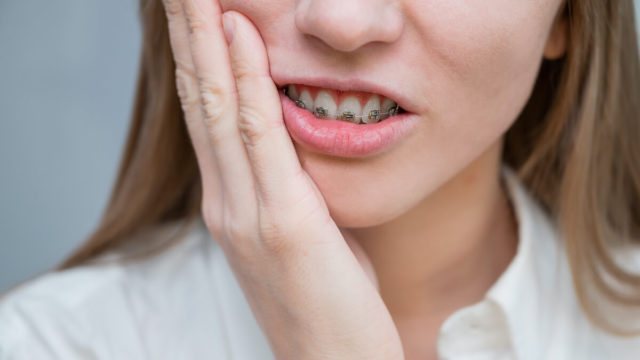Orthodontic treatment can improve your smile in many ways, but the process involves moving your teeth and jaw into proper alignment. The process can cause discomfort and pain as your teeth shift. Let’s talk about the various points where orthodontic patients may need pain relief and the best ways to find it!
Does Getting Braces Hurt?
One of the most popular questions about starting orthodontic treatment may be “do braces hurt?” The truth is that it might. While some people can manage the discomfort, others may require a little help easing braces pain.
When you first get braces, it’s common to feel some sensitivity and pain due to the amount of work in your mouth. It also takes time to get used to the brackets and wires in your mouth.
What Causes Painful Braces?
Some people may experience general discomfort while others have just one tooth that hurts with braces adjustments. Several things can contribute to braces pain, including altering blood flow around your teeth and gums as alignment shifts. Other people may have soft tissue pain from the brackets or trays rubbing the cheeks and gums.
How Long Will My Teeth Hurt After Braces are Put On?
Most orthodontic patients can expect braces pain the first week after having them put on, but some may take a little longer to adjust. Additionally, it’s common to experience braces tightening pain whenever you have an adjustment.
Is it Normal for Teeth to Hurt Randomly with Braces?
It is completely normal for teeth to hurt at random times. As your teeth move into proper alignment, you can experience temporary pain and discomfort at any point.
Do Spacers Hurt?
Spacers go between teeth to create more space to accommodate braces and orthodontic appliances. Like braces, spacers can cause some discomfort as the teeth move.
Does Invisalign Hurt?
People choose clear aligners, like Invisalign, instead of traditional braces for many reasons, but that doesn’t mean you won’t have pain. Many people who start Invisalign have pain the first week as they get used to the trays. Other Invisalign patients may experience pain in one tooth, which indicates the trays are working!
Usually, Invisalign pain isn’t unbearable or long-term. However, if you can’t manage the pain or it lasts more than a few days, reach out to your orthodontist to have them evaluate your trays.
Do Retainers Hurt?
Retainers help keep your teeth in place after you complete orthodontic treatment. They may feel strange, but you should not have pain. If your retainer hurts, it may not fit properly and require an adjustment.
Summary
Starting an orthodontic treatment with braces can sometimes cause discomfort. The most common concern for patients is whether or not the initial process of getting braces will be painful. Initially, there may be sensitivity and discomfort due to the initial adjustment and the presence of brackets and wires in your mouth, but you’ll gradually get used to them. Discomfort is most common within the first week of getting braces and during subsequent adjustments. Similarly, Invisalign may cause some discomfort as you get used to them, but it’s usually temporary and manageable.
How Do You Deal with Braces Pain?
Dealing with a sore mouth from braces isn’t fun, but it’s a part of the process that will get you the smile you dream about. If your teeth hurt from braces, remind yourself that it’s temporary and that your new smile will be worth it. Of course, there are also many ways to find braces and Invisalign pain relief!
Over-the-Counter Pain Relievers
It may be helpful to take pain relievers before you have an appointment so that the medicine takes effect sooner. That way, you may never feel the pain or discomfort.
Ice Packs or Heating Pads
Ice packs can alleviate swelling and pain, but if they don’t work you may want to try heating pads or warm compresses. Some people alternate the hot and cold compresses. It can help to apply an ice pack for about fifteen minutes, leave it off for the same amount of time, then switch to heat.
Cold Foods
Eating cold foods, like ice cream, can help ease the pain in your mouth. Popsicles and other frozen foods work much like ice packs and relieve braces pain. Be careful not to bite into any ice cubes or popsicles because you could break a bracket off.
Topical Oral Anesthetics
Over-the-counter numbing gels or creams can help in some situations. Applying it directly to the affected teeth and gums can ease painful braces.
Orthodontic Wax
Sometimes a wire pops out or you have a rough bracket that irritates the inside of your cheek. Try using a bit of orthodontic wax to cover the irritant to create a smooth surface that won’t hurt your inner cheek or gum.
Salt Water Rinse
Creating a warm saltwater solution is easy, and it can help with braces pain. Add some salt to warm water and swish it around your mouth for about a minute to ease discomfort and help prevent infection.
Soft Foods
If you just had your braces tightened and need pain relief, it may help to switch to soft foods for a few days after an adjustment. By giving your jaw a break with mashed potatoes, yogurt, oatmeal, and applesauce, you can make things easier on your sensitive teeth and gums!
Massage Your Gums
Gently massaging your gums can bring relief, especially if you have some swelling. Rub your finger in circles over the gums to reduce pain. You can even try it with an ice cube!
Keep Up with Good Oral Hygiene
Don’t let sore teeth from braces keep you from eating or maintaining good oral hygiene. With braces, it’s more important than ever to keep brushing and flossing. Follow your orthodontist’s instructions and keep up with your oral care to keep your teeth and gums healthy.
Foods to Eat During the First Week of Braces
Why does it hurt so bad when you initially receive braces on your teeth? Short answer? They’re at work! Your teeth are moving with the braces because they apply constant, mild pressure to them. This may feel uncomfortable at first, but soon you’ll be used to it, you won’t even feel it. One way of easing the discomfort- especially after readjustments, is eating a softer diet.
Breakfast
- Eggs
- Oats
- Pancakes
- Smoothies
- Yoghurt
Lunch
- PB and J
- Soup
- Egg salad
- Cheesy pasta
- Roast veggies
Dinner
- Mashed/Baked potato
- Pasta
- Soup
- Chili
Snacks
- Soft fruits
- Apple sauce
- Avocado
- Pudding
- Ice cream
Simply put, choose anything that requires little to no chewing. Depending on how you feel, you might want to start the week with smoothies, soups, and mashed potatoes before moving on to pasta, pancakes, and fruits. There is really no set time when you should start eating these foods again because they won’t harm your teeth or braces. Everything is up to how comfortable you are.
Foods to avoid
These foods shouldn’t only be avoided at the time of getting your braces, or after getting them adjusted, but also throughout your braces journey. Hard or chewy foods could cause damage to the components of your braces. Some examples include:
- Nuts
- Hard candy
- Chewy foods- No taffy!
- Popcorn
- Hard crackers
Summary
Dealing with braces pain is an inevitable part of the process, but it’s important to remember that it’s temporary and will lead to the smile you’ve always wanted. There are many ways to relieve the discomfort caused by braces. Taking over-the-counter pain relievers 30 minutes before your appointments can help, while ice packs or heating pads can reduce swelling and provide relief from any pain. Consuming cold foods like ice cream or using topical oral anaesthetics can also ease the pain. Additionally, maintaining good oral hygiene, sticking to soft foods after adjustments, and avoiding hard or chewy foods throughout your braces journey is crucial for minimizing discomfort and protecting the braces.
Remember, orthodontic treatment can help you get the smile of your dreams if you comply with treatment. It’s easy to slip up and avoid doing things when you have pain, so it may mean finding the right combination of pain relief methods to ease sore braces.
If you’re ready to start orthodontic treatment or have questions about how to relieve braces pain, the team at Jefferson Dental & Orthodontics can help. Book an appointment for a FREE consultation to get started!




